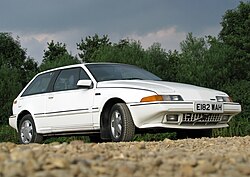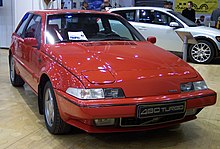Volvo 480
| Volvo | |
|---|---|
|
Volvo 480 ES (1986-1992)
|
|
| 480 | |
| Production period: | 1986-1995 |
| Class : | Compact class |
| Body versions : | Combi coupe |
| Engines: |
Petrol engines : 1.7–2.0 liters (70–90 kW) |
| Length: | 4260 mm |
| Width: | 1710 mm |
| Height: | 1320 mm |
| Wheelbase : | 2505 mm |
| Empty weight : | 1010-1025 kg |
| successor | Volvo C30 |
The Volvo 480 is a compact class coupé or shooting brake and the first front-wheel drive vehicle from Volvo . It is counted in the 400 series . The design, which is based on the design by the Dutchman John de Vries, is based on the Volvo P1800 ES, which was built from the summer of 1971 to the end of 1973 .
General
The Volvo 480 was manufactured in the Dutch plant in Born (Limburg) , from which NedCar emerged in 1991 . Earlier series such as the Volvo 66 and the Volvo 340/360 as well as the 440 and 460 series were manufactured in the former DAF plant .
Based on the 480, the 440 hatchback sedan was added in the summer of 1988, to which the classic 460 notchback version was added from the beginning of 1989.
With the introduction of the 480, Volvo began gradually converting from rear-wheel to front-wheel drive . Since Volvo had no experience with a passive rear axle, the design was carried out by the English company Lotus . The Volvo 480 was equipped exclusively with petrol engines, which were a joint development with Renault and proved to be very durable. The design and coordination of the corresponding components of the turbo engine ( pistons , connecting rods , camshafts , turbochargers , intake air ducts) were carried out by Porsche Engineering in Weissach.
From April 1986 to September 1995 a total of 76,375 Volvo 480 vehicles were produced in both left and right hand drive for Japan and the United Kingdom . Although the vehicle was originally developed for the US market (clearly recognizable by the side markers that are unusual in Europe and the pop-up headlights as a compromise for the minimum height for low beam headlights required by law in the USA ), it never found its way there due to the then unfavorable dollar exchange rate . Only two prototypes were built in 1988 according to US standards.
history
- 1986: Premiere of the 480 ES at the Geneva Motor Show in March
- 1986: Market launch in April in the following variants: naturally aspirated engine with 1.7 liter displacement and regulated catalytic converter (70 kW / 95 PS ), with unregulated catalytic converter (78 kW / 106 PS) and without catalytic converter (80 kW / 109 PS)
- 1987: From October the 480 was also available in Germany.
- 1988: Introduction of the 480 Turbo with 1.7 liter displacement with catalytic converter and 89 kW (121 PS)
- 1990: Presentation of the 480 Cabriolet at the Geneva Motor Show, which, however, never went into series production due to the insolvency of an important supplier company responsible for the tops and due to probable problems with homologation . From 1990 only vehicles with catalytic converters were offered; the output of the 1.7 liter naturally aspirated engine is increased to 75 kW (102 hp) and the tank volume is increased from 48 liters to 60 liters (optional).
- 1991: Facelift with slight changes (including more compact exterior mirrors and improved electronics). In line with the Paris Motor Show , the "Paris Edition" special model was released, which only referred to the external appearance. It included the Parisian blue metallic paintwork, two-tone full leather interior in turquoise and gray, a matching MOMO sports steering wheel, a patterned carpet and turquoise trim.
- 1992: In order to increase the attractiveness, Volvo now also offered a two-tone paint job in this model year, which was already a marketing strategy at Amazon .
- From 1993 the driver airbag was available as an option. ABS was part of the standard equipment on turbo models . The 1.7 liter naturally aspirated engine was omitted and a model with a 2.0 liter naturally aspirated engine was introduced (80 kW).
- From 1994, white indicators, ABS and airbags were standard equipment.
- The special model 480 GT was presented. Air conditioning , leather upholstery , heated seats , metallic paint, a height-adjustable passenger seat and TRACS , traction control controlled by ABS, are standard equipment on this model.
- In 1995 the special series 480 Collection was presented in Germany and 480 Celebration in Great Britain . These special series, each limited to 480 copies and numbered consecutively, often contained almost all available extras as well as some special details. The last 480 rolled off the line on September 7th.
Technical specifications
| 1.7 | 1.7 turbo | 2.0 | ||
|---|---|---|---|---|
| model | IT, S | TURBO, GT TURBO | S, ES, GT | |
| Construction period | 04 / 1986-07 / 1989 | 08 / 1989-08 / 1992 | 08 / 1987-09 / 1995 | 08 / 1992-09 / 1995 |
| Engine designation | B18E / B18F | B18EP | B18FT / B18FTM | B20F |
| Engine type | Four-cylinder petrol engine, installed transversely | Four-cylinder turbo gasoline engine, installed transversely | Four-cylinder petrol engine, installed transversely | |
| Displacement | 1721 cc | 1998 cc | ||
| power | 70–80 kW (95–109 hp) * | 75 kW (102 PS) | 88–90 kW (120–122 hp) | 80 kW (109 PS) |
| Max. Torque | 140-145 Nm | 142 Nm at 3900 rpm | 175-195 Nm at 3300 rpm | 165 Nm at 3500 rpm |
| Gear type | 5-speed manual or 4-speed automatic | |||
| Drive type | Front wheel drive | |||
| Empty weight | 1016 kg, max. 1440 kg | 1040 kg, max. 1455 kg | 1021 kg, max. 1440 kg | |
| Top speed ** | 190 km / h | 200 km / h | 195 km / h | |
| Acceleration 0-100 km / h ** | 9.5 s | 8.9 s | 9.5 s | |
* Various versions with regulated (95 PS, 102 PS, 106 PS) and without catalytic converter (109 PS)
** with manual transmission
The 1.7 l B18E was identical to the Renault F3N engine (injection), which u. a. in the Renault 19 (90 PS in the TXE / TXI) and Renault 5 (94 PS in the GTE). There the engine had 1721 cm³ and was only available with a regulated catalytic converter. The 2.0 l B20F was identical to the Renault F3R engine, which u. a. in the Renault Laguna I (113 or 114 PS) and Renault Espace III (114 PS) were installed. Only the pistons and cylinder head are unique to Volvo.
Quantities
Between spring 1986 and late summer 1995, a total of 76,375 vehicles of all models were produced. These extend over the years as follows:
| production | number of pieces | |
|---|---|---|
| 1986 | 851 | |
| 1986-1987 | 11,243 | |
| 1987-1988 | 15,944 | |
| 1988–1989 * | 12,295 | |
| 1989-1990 | 9968 | |
| 1990–1991 ** | 7297 | |
| 1991-1992 | 7439 | |
| 1992-1993 | 4908 | |
| 1993–1994 *** | 2870 | |
| 1994-1995 | 3560 | |
* Introduction of the B18FT (B18F will be replaced)
** Introduction of the B18EP
*** Introduction of the B20F (B18EP will be replaced) The number of items manufactured relates to the model year (a model year 1995 can already be manufactured in 1994). Different quantities are also mentioned in various ways, but these are likely due to the fact that Volvo did not actually assign all chassis numbers.
useful information
design
Volvo Sweden launched a design competition in which, in addition to the Swedes themselves, Volvo Netherlands and the well-known Italian design studio Bertone took part. Volvo Sweden compiled the basic requirements in a “Red Book”, and in the end the study from the Netherlands won. The body reaches a c W value of 0.34.
The 480 is often compared to a vehicle from Honda , the Accord Aerodeck. Apart from the visual similarities, the two vehicles have nothing in common. Both manufacturers are often accused of having copied from the other. The fact is that the Honda came onto the market earlier - partly because of the longer development time of the Volvo 480 and partly because Volvo wanted to appeal to a completely different target group. In fact, more emphasis was placed on road holding, comfort, durability and maximum safety in the 480.
logo
Volvo Sweden had serious problems with the designers placing the air intake below the bumper - so the Volvo logo was never really in view. But since Volvo Sweden also realized that a sporty car should have a deep front, the compromise was found to put the Volvo lettering on the left side of the front mask .
At the rear, the logos were placed on the rear window.
Pop-up headlights
The pop -up headlights , which are also affectionately known as sleeping eyes , were not used for aerodynamic advantages, but rather because the 480 should also come on the market in the USA and there was a minimum height (above the street) for dipped headlights. The striking styling with the deep front would not have been possible without the pop-up headlights.
materials
Volvo had special plastics developed that were used outdoors and that should look like the painted metal parts. Among other things, the front mask, the bonnet and part of the roof strips consisted of a fiberglass composite. Only the turbo models and the color variant black metallic (color code 305) always had painted bumpers. The more economical model variant S, on the other hand, had neither painted bumpers nor standard aluminum rims during the entire production period.
Individual evidence
- ↑ a b c d e f Dieter Günther & Matthias Pfannmüller: Volvo Typenkunde - passenger cars from 1927 . 2nd Edition. Delius Klasing Verlag, Bielefeld 2011. ISBN 978-3-7688-3367-7 . Pp. 84-85
- ↑ a b motorsport-total.com of July 10, 2018, 30 years of the Volvo 440: When Volvo reached for the stars , accessed on April 27, 2019.
- ↑ ntv.de of January 10, 2018, Volvo 440 - legendary Sweden edges (there picture with subtitle), accessed on April 27, 2019.
- ↑ auto.de, Tradition: 25 Years of the Volvo 400 Series - Snow White instead of sleeping pills , available on April 27, 2019.
- ↑ The story of the little elk - Volvo 480. In: www.der-kleine-elch.de. Retrieved April 5, 2016 .








